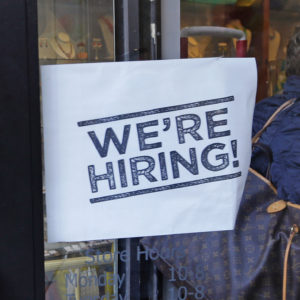As with prior presidents, Donald Trump is taking credit for last week’s good unemployment numbers. Politicians like to talk about the jobs that they create, but they don’t create jobs. At best, they move jobs from one place to another by taxing one group of people and spending the revenue on a different group. At worst, they destroy jobs by imposing unnecessary regulations and licensing requirements.
Actual job creation comes when entrepreneurs and able-bodied, educated and skilled workers come together in the marketplace. Politicians aren’t involved.
But behind the news that unemployment has dropped to 3.8 percent — the lowest since the early 2000s — are some caveats worth noting. Contrary to what too many people believe, there aren’t merely two options: that one is either employed or unemployed. There is a third option: one can be non-employed.
A non-employed person is one who doesn’t have a job but isn’t actively looking for one either. Full-time students, the retired, and stay-at-home parents are some examples. But a problem arises when we try to define “actively looking.” It turns out that there’s no clear way to distinguish someone who is actively looking for a job from someone who isn’t.
And this becomes a problem when a worker has been unemployed for so long that, though wanting a job, he doesn’t see the point in spending any more energy looking for one. This becomes a problem because when that worker stops looking for work, the government stops counting him as unemployed.
Following the Great Recession, American workers were out of work for historically unprecedented lengths of time. From 1950 to the Great Recession, the longest the average unemployed American had ever been unemployed was 21 weeks. By 2011, the average unemployment length had almost doubled to more than 40 weeks. The longer a person is unemployed, the greater is the chance that he will become discouraged and stop looking for work.
And during the Great Recession, a lot of Americans became discouraged. From January 2008 to January 2012, the fraction of the working age population who were either employed or actively looking for work fell 1.8 percentage points. In other words, over those four years, 3.6 million working-age people had dropped out of the labor force.
The good news is that the fraction of working-age people in the labor force is steadily rising back to pre-recession levels, but the figure is still off by around half a percentage point. That doesn’t sound like much, but it equates to almost 1 million jobs. That’s an additional 1 million working-age Americans who, in pre-Great Recession circumstances, would either be employed or actively looking for work. If we add those people back into the numbers, the unemployment rate is actually closer to 4.2 percent. That’s not bad, but it’s almost another year’s worth of job growth beyond what we have had so far.
Part of the reason it has taken a decade for the economy to recover from the Great Recession is that politicians have had too little respect for their ability to destroy jobs and too much faith in their ability to create them. Each new interference in job markets, from minimum wages to occupational licensing to higher business taxes to more burdensome regulations, though doubtlessly well-meant, is one more opportunity for politicians to make it harder for workers and entrepreneurs to create the jobs that make us all better off.

